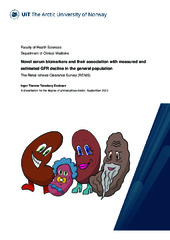| dc.contributor.advisor | Melsom, Toralf | |
| dc.contributor.author | Enoksen, Inger Therese Tønsberg | |
| dc.date.accessioned | 2023-08-31T07:27:37Z | |
| dc.date.available | 2023-08-31T07:27:37Z | |
| dc.date.issued | 2023-09-29 | |
| dc.description.abstract | Chronic kidney disease (CKD) is an increasing health problem globally, now affecting 8-13% of the world’s population. The prevalence of CKD increases dramatically with age because kidney function, as assessed by the glomerular filtration rate (GFR), declines with age. The rate of GFR loss varies significantly between individuals regardless of known risk factors. However, current kidney biomarkers are suboptimal at predicting those at high risk of accelerated glomerular filtration rate (GFR) decline, especially when GFR is >60 ml/min/1.73m2. Thus, there is an unmet need to identify high-risk individuals or groups of people for early measures to delay or prevent CKD development.
This thesis explores the relationship between baseline levels of 18 serum biomarkers and GFR decline over 5.6 and 11.0 years of follow-up in 1627 individuals in a healthy general middle-aged population, without cardiovascular disease, kidney disease, or diabetes at baseline. The GFR was measured (mGFR) using iohexol clearance at baseline and follow-up. We also investigated whether there are discrepancies in the relationship between the biomarkers and GFR decline when using the measured GFR or the commonly used estimated GFR (eGFR) from creatinine or cystatin C.
Only one biomarker (MMP7) was independently associated with GFR decline independent of follow-up time, estimated or measured GFR, or how GFR decline was defined. MMP7 also predicted incident CKD and accelerated GFR decline beyond traditional CKD risk factors. Associations between the other proteins and GFR decline varied depending on whether the GFR was estimated or measured using iohexol. Thus, for some biomarkers, associations with eGFR decline may not be reproducible with mGFR. Results from studies on biomarkers for GFR decline, using eGFR and particularly eGFR from cystatin C, should be interpreted with caution. | en_US |
| dc.description.doctoraltype | ph.d. | en_US |
| dc.description.popularabstract | Permanently reduced kidney function is very common in older persons and leads to increased morbidity and mortality. Some individuals are at risk of a fast decline in kidney function with age, despite being relatively healthy. However, today’s kidney function markers are suboptimal for predicting who these individuals are. Thus, there is an unmet need to identify these persons to initiate preventive measures. This thesis investigates 18 promising serum biomarkers in a population survey of 1627 healthy middle-aged individuals who got their kidney function measured accurately using the contrast agent iohexol one or more times during 11.0 years of follow-up. The relationship between biomarker concentrations at the first visit and future decline in kidney function was investigated. Only one biomarker (MMP7) was robustly linked to a faster decline in kidney function. Whether MMP7 could be used as a novel biomarker to identify who will develop CKD should be tested in other studies. | en_US |
| dc.identifier.uri | https://hdl.handle.net/10037/30560 | |
| dc.language.iso | eng | en_US |
| dc.publisher | UiT The Arctic University of Norway | en_US |
| dc.publisher | UiT Norges arktiske universitet | en_US |
| dc.relation.haspart | <p>Paper 1: Enoksen, I.T., Svistounov, D., Norvik, J.V., Stefansson, V.T.N., Solbu, M.D., Eriksen, B.O. & Melsom, T. (2022). Serum matrix metalloproteinase 7 and accelerated glomerular filtration rate decline in a general non-diabetic population. <i>Nephrology Dialysis Transplantation, 37</i>(9), 1657-1667. Also available in Munin at <a href=https://hdl.handle.net/10037/23837>https://hdl.handle.net/10037/23837</a>.
<p>Paper 2: Enoksen, I.T., Rinde, N.B., Svistounov, D., Norvik, J.V., Stefansson, V.T.N., Solbu, M.D., Eriksen, B.O. & Melsom, T. (2023). Validation of eGFR for Detecting Associations Between Serum Protein Biomarkers and Subsequent GFR Decline. Article in press, now published in <i>Journal of the American Society of Nephrology, 34</i>(8), 1409-1420. Published version not available in Munin due to publisher’s restrictions. Published version available at <a href= https://doi.org/10.1681/ASN.0000000000000147>https://doi.org/10.1681/ASN.0000000000000147</a>.
<p>Paper 3: Rinde, N.B., Enoksen, I.T., Melsom, T., Fuskevåg, O.M., Eriksen, B.O. & Norvik, J.V. (2023). Nitric oxide precursors and dimethylarginines as risk factors for accelerated GFR decline in the nondiabetic general population. <i>Kidney International Reports, 8</i>(4), 818-826. Also available at <a href=https://hdl.handle.net/10037/30295>https://hdl.handle.net/10037/30295</a>. | en_US |
| dc.rights.accessRights | openAccess | en_US |
| dc.rights.holder | Copyright 2023 The Author(s) | |
| dc.rights.uri | https://creativecommons.org/licenses/by-nc-sa/4.0 | en_US |
| dc.rights | Attribution-NonCommercial-ShareAlike 4.0 International (CC BY-NC-SA 4.0) | en_US |
| dc.subject | VDP::Medical disciplines: 700::Clinical medical disciplines: 750::Nephrology, urology: 772 | en_US |
| dc.subject | VDP::Medisinske Fag: 700::Klinisk medisinske fag: 750::Nefrologi, urologi: 772 | en_US |
| dc.subject | VDP::Medical disciplines: 700::Health sciences: 800::Epidemiology medical and dental statistics: 803 | en_US |
| dc.subject | VDP::Medisinske Fag: 700::Helsefag: 800::Epidemiologi medisinsk og odontologisk statistikk: 803 | en_US |
| dc.title | Novel serum biomarkers and their association with measured and estimated GFR decline in the general population | en_US |
| dc.type | Doctoral thesis | en_US |
| dc.type | Doktorgradsavhandling | en_US |


 English
English norsk
norsk

